
Sergeant Darrell Samuel Cole was a United States Marine who posthumously received the United States' highest military decoration, the Medal of Honor, for his conspicuous gallantry at the Battle of Iwo Jima during World War II.

The Battle of Kwajalein was fought as part of the Pacific campaign of World War II. It took place 31 January – 3 February 1944, on Kwajalein Atoll in the Marshall Islands. Employing the hard-learned lessons of the Battle of Tarawa, the United States launched a successful twin assault on the main islands of Kwajalein in the south and Roi-Namur in the north. The Japanese defenders put up stiff resistance, although outnumbered and under-prepared. The determined defense of Roi-Namur left only 51 survivors of an original garrison of 3,500.
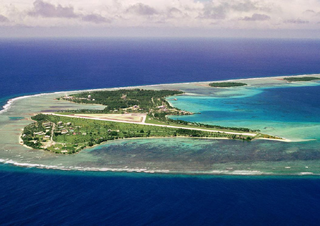
Roi-Namur is an island in the north part of the Kwajalein Atoll in the Marshall Islands. Today it is a major part of the Ronald Reagan Ballistic Missile Defense Test Site, hosting several radar systems used for tracking and characterizing missile reentry vehicles (RV) and their penetration aids (penaids).
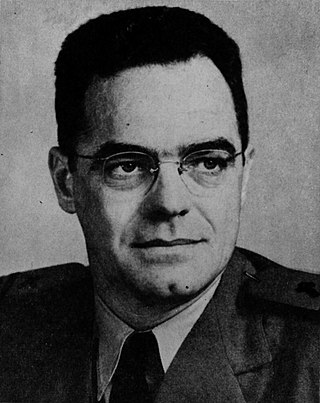
Joseph Timothy O'Callahan was a Jesuit priest and, during World War II, a United States Navy chaplain. He was awarded the U.S. military's highest decoration, the Medal of Honor, for his actions during and after an attack on the aircraft carrier aboard which he was serving, USS Franklin.
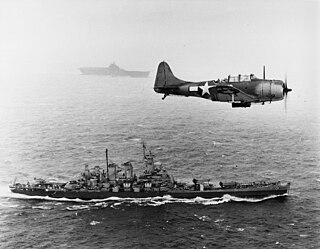
The Gilbert and Marshall Islands campaign were a series of battles fought from August 1942 through February 1944, in the Pacific theatre of World War II between the United States and Japan. They were the first steps of the drive across the Central Pacific by the United States Pacific Fleet and Marine Corps. The purpose was to establish airfields and naval bases that would allow air and naval support for upcoming operations across the Central Pacific. Operation Galvanic and Operation Kourbash were the code names for the Gilberts campaign that included the seizures of Tarawa and Makin, during the Battle of Tarawa on 20–23 November and the Battle of Makin on 20–24 November 1943. Operation Flintlock and Operation Catchpole were aimed at capturing Japanese bases at Kwajalein, Eniwetok, and Majuro in the Marshall Islands.

Richard Beatty Anderson was a United States Marine who sacrificed his life during World War II and received the Medal of Honor posthumously for his heroism.

Joseph Jeremiah McCarthy was a mustang officer in the United States Marine Corps Reserve, who served during World War II and the Korean War. He was also the Superintendent of Ambulances in the Chicago Fire Department; however, with respect for his wartime heroics, firefighters continued to address him by his wartime military rank of “Captain.”

Lieutenant Colonel Aquilla James Dyess was a United States Marine Corps officer who was a posthumous recipient of the Medal of Honor for "conspicuous gallantry and intrepidity at the risk of his life" at the head of his troops during World War II, in the Battle of Kwajalein, on Namur Island, Kwajalein Atoll, Marshall Islands on February 2, 1944.

The 2nd Battalion, 25th Marines (2/25) is a reserve infantry battalion in the United States Marine Corps.

3rd Battalion, 14th Marine Regiment (3/14) is a reserve artillery battalion comprising four firing batteries and a headquarters battery. The battalion is based in Bristol, Pennsylvania and its primary weapon system is the M777 howitzer with a maximum effective range of 30 km. They fall under the command of the 14th Marine Regiment and the 4th Marine Division.
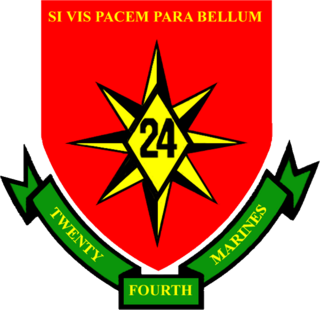
The 24th Marine Regiment was one of three infantry regiments in the 4th Marine Division of the United States Marine Corps. Its last headquarters before being deactivated on 9 September 2013 was in Kansas City, Missouri.

1st Battalion, 23rd Marines (1/23) is one of 32 infantry battalions in the United States Marine Corps, and one of only eight battalions found in the reserve. It is located throughout Texas and Louisiana consisting of approximately 1000 Marines and Sailors. They fall under the command of the 23rd Marine Regiment and the 4th Marine Division.

3rd Battalion, 24th Marines (3/24) was a reserve infantry battalion in the United States Marine Corps. The battalion was first formed in 1943 for service in the Pacific Theater of Operations during World War II, taking part in a number of significant battles including those at Saipan and Iwo Jima before being deactivated at the end of the war. In the early 1960s, the unit was reactivated as a reserve battalion. It was located throughout the Midwestern United States and consisted of approximately 800 marines and sailors. The battalion was part of the 24th Marine Regiment and the 4th Marine Division. Recent operations included tours in Iraq and Afghanistan. On May 19, 2013, the battalion was deactivated (retired) as a part of 2013 Marine Corps Force Restructuring, along with the 24th Marine Regiment. 3/24 personnel were reallocated to 23rd Marine Regiment, with the majority of the companies becoming 3rd Battalion, 23rd Marines.
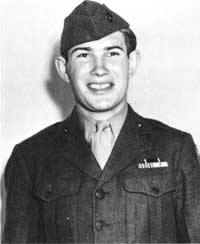
Richard Keith Sorenson was a United States Marine who, as a private, received the Medal of Honor during World War II for his heroism during the Marine landing on Kwajalein Atoll on the night of February 1–2, 1944. He threw himself on a Japanese grenade that was part of US munitions captured during the Battle of Bataan, to save the lives of five fellow Marines. Although fragments of the grenade ripped through his thighs, hips, right arm and right leg, he survived the action. Of the 27 Marines who similarly threw themselves on grenades to save the lives of their fellow Marines during World War II, Sorenson was one of only four who lived. Fellow Medal of Honor recipients Richard E. Bush, Jacklyn H. Lucas and Carlton R. Rouh were the other three survivors.

Franklin Augustus Hart was a four-star general in the United States Marine Corps who served more than thirty-seven years. His varied and colorful career included service during the two World Wars, sea duty aboard several ships of the Navy, and tours in Haiti, Nicaragua, and the Dominican Republic.

Captain Victor "Transport" Maghakian was an Armenian-American member of the United States Marine Corps during World War II. As a gunnery sergeant, he led his platoon through some of the bloodiest fighting in seven South Pacific campaigns, including the Naval Battle of Guadalcanal. Having received over two dozen medals and awards, he is considered one of the most decorated American soldiers of the war.

Samuel Calvin Cumming was a highly decorated officer of the United States Marine Corps with the rank of major general. He is most noted for his service as assistant division commander of the 4th Marine Division during Mariana Islands Campaign and previously as commanding officer of 25th Marine Regiment during Battle of Kwajalein. He was a nephew of Hugh S. Cumming, former Surgeon General of the United States.

The John V. Power statue is a monumental statue in Worcester, Massachusetts, United States. Dedicated in 1947, the statue honors John V. Power, a Marine from Worcester who was killed in action during World War II and was posthumously awarded the Medal of Honor. The statue is located near Worcester City Hall and is one of several war memorials in the city.

Marine Night Fighter Squadron 532 was a United States Marine Corps night fighter squadron that was commissioned during World War II. The squadron, which flew the F4U-2 Corsair, was the second night fighter squadron commissioned by the Marine Corps, the first to fly a single-seat, radar-equipped night fighter, and the only Marine squadron to fly the F4U-2 in combat. VMF(N)-532 saw extensive combat operations throughout 1944 in support of Marine Corps operations at Kwajalein Atoll and the Mariana Islands. The squadron was decommissioned on 31 May 1947, as part of the post-war draw down of the service. Since then, no other Marine Corps squadron has carried the lineage and honors of VMF(N)-532.

Naval Base Kwajalein was United States Navy base built on Kwajalein Atoll, in the Marshall Islands to support the World War II efforts in the Pacific War. The base was built after the Battle of Kwajalein ended 3 February 1944. The US Navy built airfields, a seaport and a craft repair depot on the captured islands. The base was part of the vast Naval Base Marshall Islands.




















